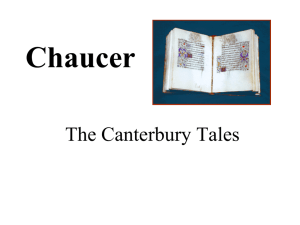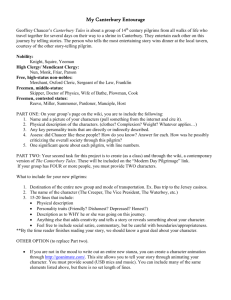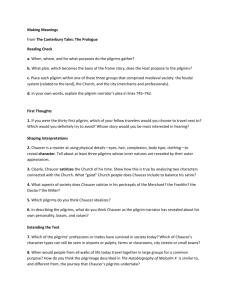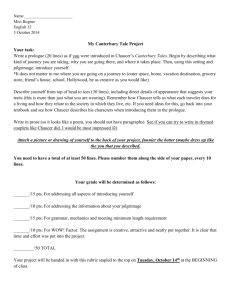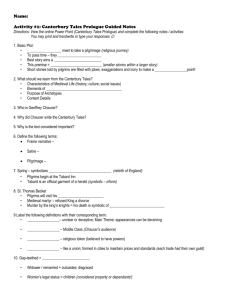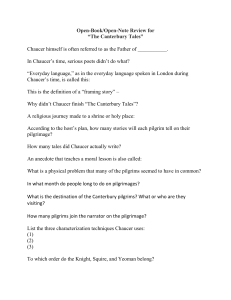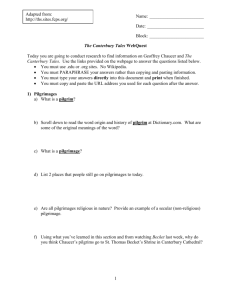The Canterbury Tales
advertisement
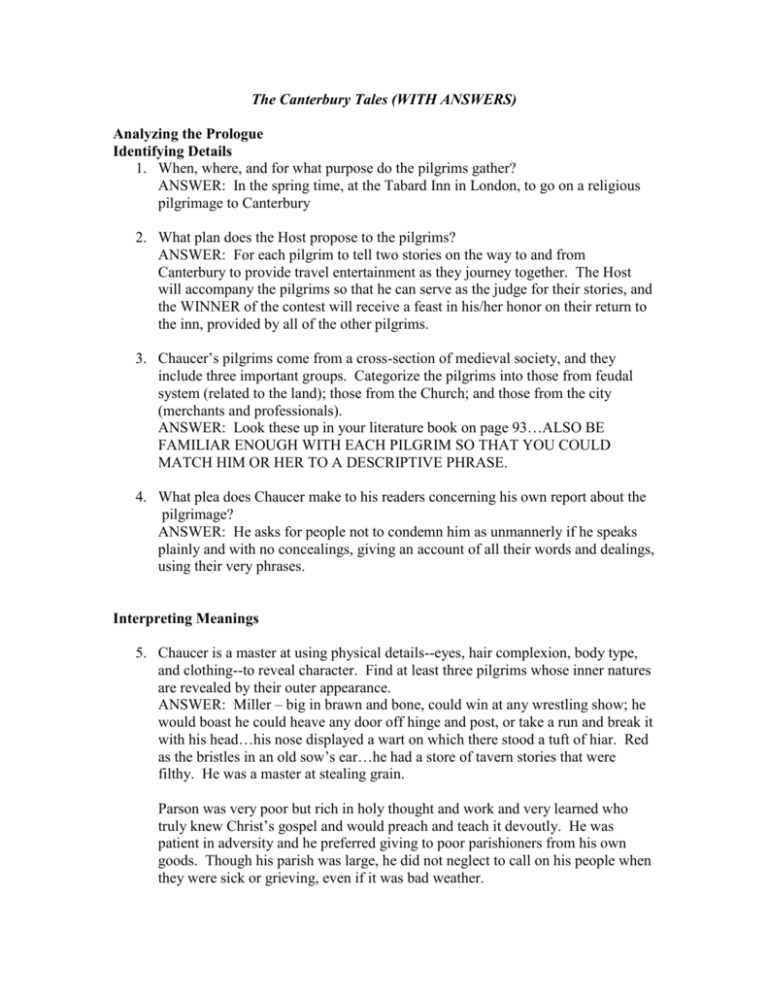
The Canterbury Tales (WITH ANSWERS) Analyzing the Prologue Identifying Details 1. When, where, and for what purpose do the pilgrims gather? ANSWER: In the spring time, at the Tabard Inn in London, to go on a religious pilgrimage to Canterbury 2. What plan does the Host propose to the pilgrims? ANSWER: For each pilgrim to tell two stories on the way to and from Canterbury to provide travel entertainment as they journey together. The Host will accompany the pilgrims so that he can serve as the judge for their stories, and the WINNER of the contest will receive a feast in his/her honor on their return to the inn, provided by all of the other pilgrims. 3. Chaucer’s pilgrims come from a cross-section of medieval society, and they include three important groups. Categorize the pilgrims into those from feudal system (related to the land); those from the Church; and those from the city (merchants and professionals). ANSWER: Look these up in your literature book on page 93…ALSO BE FAMILIAR ENOUGH WITH EACH PILGRIM SO THAT YOU COULD MATCH HIM OR HER TO A DESCRIPTIVE PHRASE. 4. What plea does Chaucer make to his readers concerning his own report about the pilgrimage? ANSWER: He asks for people not to condemn him as unmannerly if he speaks plainly and with no concealings, giving an account of all their words and dealings, using their very phrases. Interpreting Meanings 5. Chaucer is a master at using physical details--eyes, hair complexion, body type, and clothing--to reveal character. Find at least three pilgrims whose inner natures are revealed by their outer appearance. ANSWER: Miller – big in brawn and bone, could win at any wrestling show; he would boast he could heave any door off hinge and post, or take a run and break it with his head…his nose displayed a wart on which there stood a tuft of hiar. Red as the bristles in an old sow’s ear…he had a store of tavern stories that were filthy. He was a master at stealing grain. Parson was very poor but rich in holy thought and work and very learned who truly knew Christ’s gospel and would preach and teach it devoutly. He was patient in adversity and he preferred giving to poor parishioners from his own goods. Though his parish was large, he did not neglect to call on his people when they were sick or grieving, even if it was bad weather. Woman from Bath had had five husbands, in addition to other company in youth. She had traveled on pilgrimages three times to Jerusalem. She knew the remedies for love’s mischances, an art in which she knew the oldest dances. 6. Clearly, Chaucer satirizes the Church of his time in the Prologue. Show how this is true by analyzing two characters connected with the church. ANSWER: Chaucer shows the genuine character of the parson (see above in #5) and the hypocritical character of the Pardoner who sold false relics, trying to convince naïve people to believe that they could receive some form of pardon by this. He also made more money in one day than the parson made in a month or two. (These two opposite church characters show that there were people who claimed to be religious but were hypocritical and false. It also shows that there were genuine people as well who lived what they taught.) 7. Where does Chaucer balance his satire by presenting a “good” churchman or woman? ANSWER: See above for the parson. Also, the parson’s brother, the plowman, was also a good church man who lived out his Christian claims by being honest, living in peace, and charity, and obeying what the Bible (Gospel) taught him, loving God best with all his heart and mind and then his neighbor as himself. 8. Where does Chaucer satirize other aspects of his own society? 9. ANSWER: The Summoner who basically was a pimp of his day, and he is shown to have some kinds of diseases and infections of the skin, drank a lot, and made deals with people to his own favor, of course. 10. Which characters do you think Chaucer idealizes? ANSWER: The knight is described by many good deeds and service without any negative or putrid descriptions. The prioress is also described in a delicate kind of way with seemingly positive descriptions. 11. In describing the pilgrims, what has Chaucer revealed about his own personality, biases, and values? ANSWER: Answers will vary for this one. Decide what you think about this. 12. Which of the pilgrims’ professions or trades have survived in society today? ANSWER: Nuns, priests, monks, merchants, lawyers, students (clerks), cooks, sailors (shipmans), physicians, parsons, farmers (plowmen). 13. Which of the character “types” presented here have contemporary equivalents? ANSWER: Decide this one on your own. 14. What events in contemporary life could be compared to the pilgrimage to Canterbury? That is, when would people from all walks of life today travel together in large groups for a common purpose, whether that purpose is religion or not? How are these “journeys” similar to, and different from the journey that Chaucer’s pilgrims undertake? ANSWER: People travel to all kinds of sporting events together, they attend conferences together, they sometimes still go on pilgrimages together, they visit famous monuments and places together.
